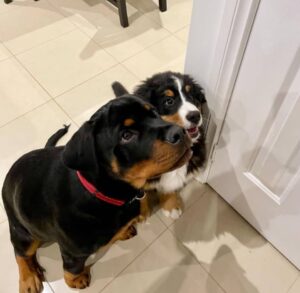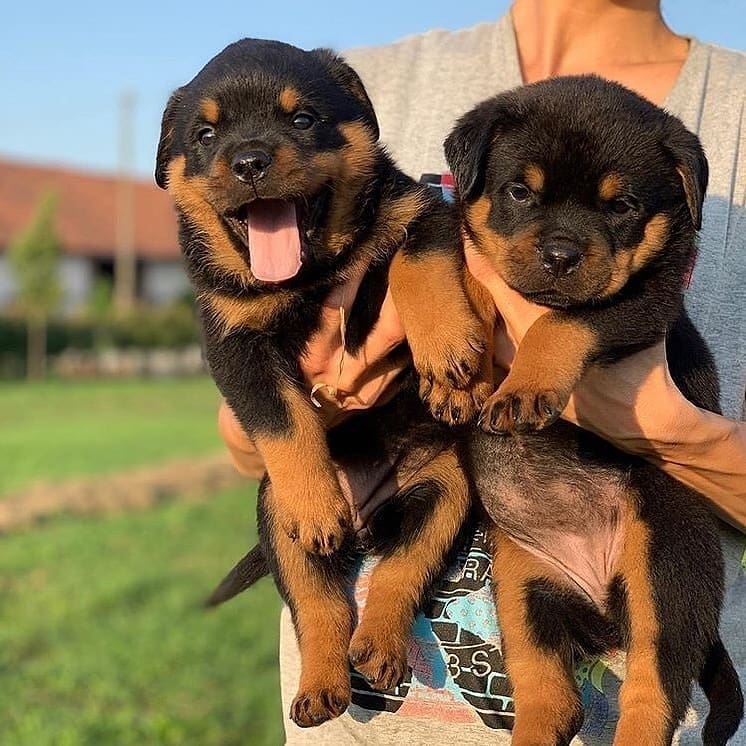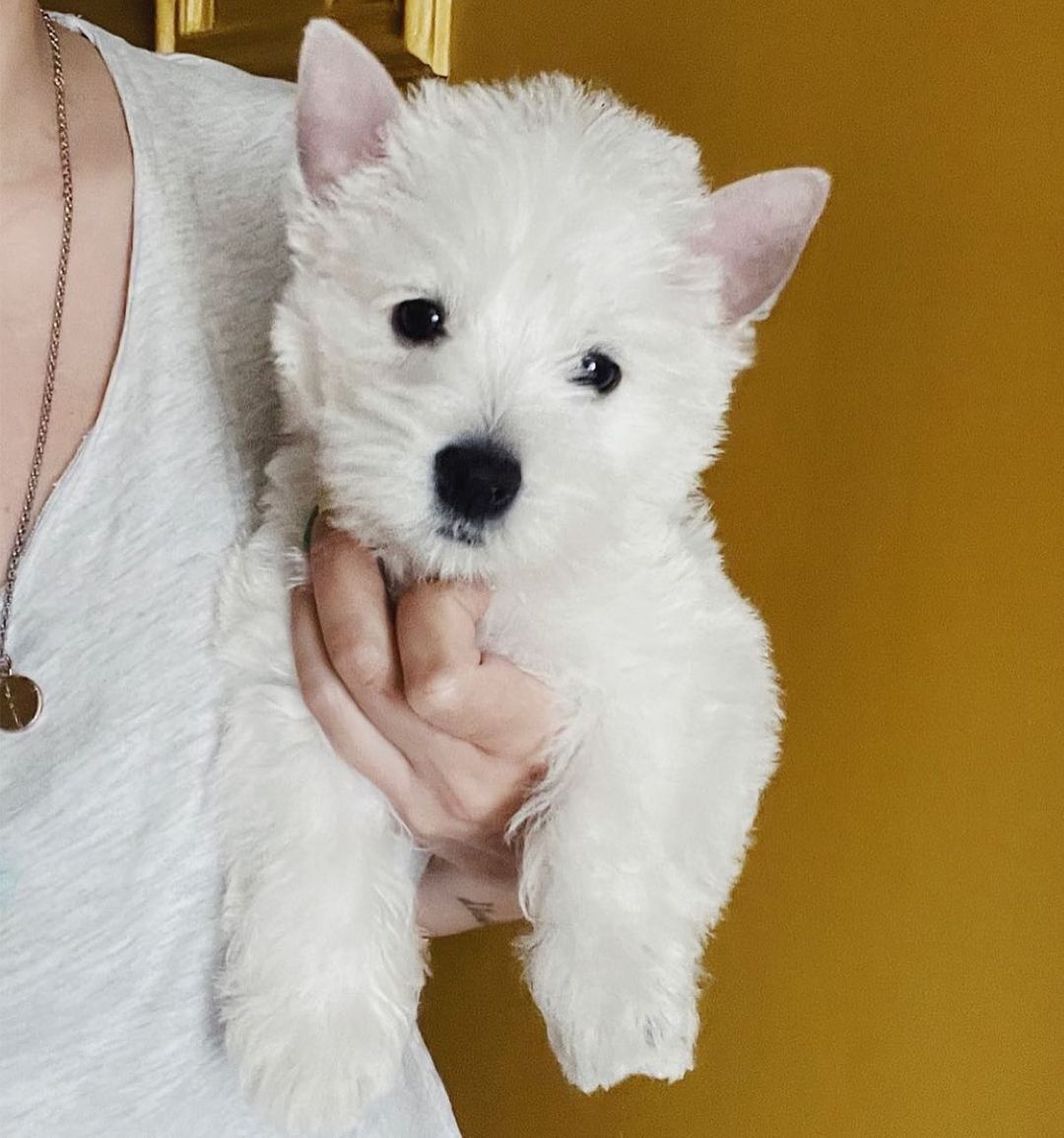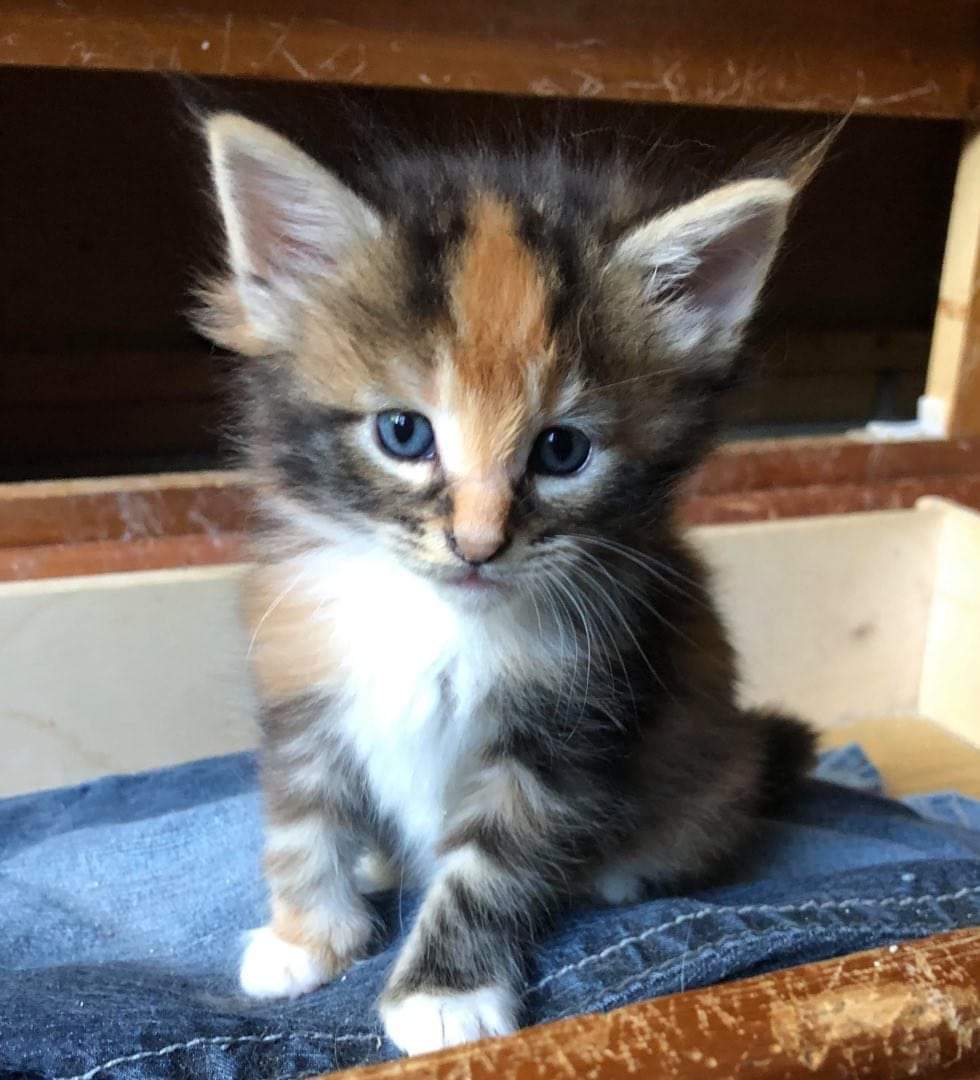Description
Beyond their captivating aesthetics, Rottweiler puppies are renowned for their unwavering loyalty and protective nature. They forge deep bonds with their human companions, making them ideal guardians and devoted family members. Their intelligence and eagerness to please make them highly trainable, allowing you to shape them into well-rounded and obedient companions.
Despite their robust exterior, Rottweiler puppies have a gentle and affectionate side. They thrive on affection and love being part of a close-knit family. Whether it’s snuggling up on the couch or engaging in outdoor activities, these puppies will eagerly join in on the fun and bring endless joy to your household.
Our Rottweiler puppies receive the utmost care and attention from our experienced breeders. They are raised in a nurturing environment, ensuring they are well-socialized and adaptable to various situations. Prioritizing their health, each puppy undergoes regular veterinary check-ups and vaccinations, guaranteeing they start their lives with a clean bill of health.
When you bring a Rottweiler puppy into your home, you’re not just welcoming a new pet; you’re inviting a lifelong companion and a devoted protector. Their unwavering loyalty and affection will create cherished memories and unforgettable moments that will enrich your life for years to come.
Don’t miss the opportunity to add one of these remarkable Rottweiler puppies to your family. Contact us today to learn more about these exceptional companions and start the journey to welcoming your new fur-ever friend!
History of Rottweilers
maintained as driving or herding dogs. Alongside the Roman legions, they drove the livestock and protected the civilians as they marched over the Alps. These Rottweiler naturally crossed paths and mingled with the local dogs in the Rottweiler region. The primary duties of the Rottweiler now included herding cattle, protecting their owners’ land, and driving them. This breed, formerly known as the ” Rottweiler butcher’s dog, butcher’s dog,” got its name from the former free city of Rottweiler. This breed of dog was created by the butchers only for show, and
utility. Eventually, a superior driving and watch dog that was also a draught dog emerged.
The increased need for police dogs in the years leading up to World War I resulted in a resurgence of interest in Rottweilers. Rottweilers served in a variety of capacities throughout World Wars I and II, including as security dogs, ambulances, messengers, and draught animals.
The first Rottweiler club in Germany was established on January 13, 1914, as the Dutcher Rottweiler-Klub (DRK, German Rottweiler Club). On April 27, 1915, the Sueddeutsche Rottweiler-Klub (SDRK, South German Rottweiler Club) was established, and on April 27, 1915, the IRK (International Rottweiler Club) was established. About 500 Rottweilers were counted by the DRK, and 3,000 by the SDRK. The objectives of the
There were two distinct clubs. The DRK did not place much attention on the Rottweiler’s morphology in favor of producing working dogs.
In 1921, the different German Rottweiler Clubs united to establish the Allgemeiner Deutscher Rottweiler Klub, also known as the General German Rottweiler Club. On January 27, 1924, this was formally noted in the Stuttgart district court’s register of clubs and associations.[9] The ADRK is known all over the world as the Rottweiler’s home club.
The American Kennel Club formally recognized the Rottweiler in 1931.[11] Rottweilers made their debut in Britain in the 1936 Crufts dog show. A breed-specific register was established in 1966. In reality, the Rottweiler breed had the highest registration rate in the mid-1990s, marking the breed’s peak popularity by the Kennel Club of America.[12] The Rottweiler was named the ninth most popular purebred dog in the US by the American Kennel Club in 2017.
TECHNICAL DESCRIPTIPON OF Rottweiler AND Rottweiler puppies
Head: The skull of Rottweiler and of course same as the Rottweiler puppies, is medium in length and somewhat wide in the area between the ears. When viewed from the side, the forehead line has a moderate arch, and the occipital bone is prominently developed but not overly so. The halt is not too strong. Not too deep a frontal groove. The nose of a Rottweiler is well-developed, broad rather than round, has comparatively large nostrils, and is consistently black. It is ideal for the muzzle to appear neither longer nor shorter than the cranial region. The length of the skull and the muzzle are roughly one to one and a half. The nasal bridge has a moderate taper, is broad at the base, and is straight. The mouth’s corner is hidden by the tightly fitting, black lips. If the gums are not black, or as dark as you can get. The jaws are large and robust in both the upper and lower jaws. The FCI Standard states that rottweilers should have a scissor bite, with their 42 teeth in a strong and full dentition, with their upper incisors nearly overlapping their lower incisors. There should be a noticeable (but not excessive) zygomatic arch. Strong and broad jaws, including upper and lower. 42 teeth in a strong, complete dentition with a scissor bite, where the upper and lower incisors overlap. The eyes ought to be medium in size, almond-shaped, and have a deep brown hue. Since the eyelids fit closely, they shouldn’t drop. The ears are triangular in shape, medium in size, widely spaced, and positioned high on the head. The skull seems broader when the ears are positioned near to the head. The epidermis on Overall, the head fits snugly. The dog’s brow could furrow slightly when it’s alert. Problems: Head shaped like a dog. extremely broad skull; narrow, light, too short, lengthy, coarse, or overly mimosoid head (lack of stop, too little stop, or too strong stop). extremely deep frontal groove. Foreface long, pointed, or excessively short muzzle (a muzzle that is less than forty percent of the head’s length is considered excessively short). split nose, aquiline nose, pale or speckled nose (butterfly nose), Roman nose (convex nasal bridge) or dish-faced nose (concave nasal bridge). bite with a pincer. Underjaw molars are not aligned in a straight line. Serious Errors: Too ponderous and stolid in overall appearance.[3] Neck The neck is clean, well-muscled, somewhat long, slightly arched, and free of throatiness.
Body The back is robust, strong, and straight. The loins are deep, powerful, and short. The croup is neither flat nor disappearing; it is medium in length, broad, and somewhat rounded. The chest has a well-developed forechest and well-sprung ribs, and it is spacious, broad, and deep, making up around 50% of the height of the shoulders. There is no tucking in the flanks. Tail According to the FCI 2018 Standard: When in its normal state, it is robust and level, extending the upper line; when moving or being agitated, it can be carried upward in a gentle curve; when it is relaxed, it may be hanging. The tail is either slightly longer or extends about to the hocks when positioned along the leg.[3] It used to be customary to dock the tail at the first or secondcombined. Nonetheless, the majority of nations now forbid docking, and the FCI Country of Origin Breed Standard reflects this.[3] The FCI Standard was changed in 2018 to designate the Natural Bob Tail, often known as “Stumpy,” as a “Disqualifying Fault” in addition to “kink tail, ring-tail, with strong lateral deviation,” despite it having previously been “preferred” in earlier Standards.[3] Legs The front legs are straight and spaced apart when viewed from the front. When viewed from the side, the forearm is upright and straight. The shoulder blade has a about 45-degree slope. The shoulders have a relaxed attitude. The upper arm fits the body closely. The forearm has a well-defined muscle structure. Pasterns are robust but not steep, with a hint of spring. The front The feet exhibit a round shape, tight arch, and hard pads. The nails are robust, short, and black. The hind legs are straight and spaced apart when viewed from the back. Obtuse angles form when the dog is standing free between the hip bone, the lower thigh and the metatarsal, and the upper thigh and the upper thigh. The upper leg is broad, somewhat lengthy, and heavily muscled. The lower leg is lengthy, sinewy, and has a robust, broad muscular mass. The hocks are not steep, but rather strong and well-angled. The front and rear feet are not quite as long as the hind feet. Strong, arched toes are just as tense as the front foot. The FCI Standard for Gait states: Dogs that trot are called Rottweilers. When moving, the back stays stable and comparatively steady. Harmonious, steady, energetic, unrestrained, and with a good gait. Nevertheless, “sluggish action while trotting” is regarded as a “Severe Fault”.[3] The American Kennel Council states that a Rottweiler’s typical gait is a trot. The Rottweiler is a trotter as a result. In this breed, trotting is necessary and by no means a flaw. The Rottweiler should exhibit this movement naturally; else, they risk being disqualified from the show ring. The Rottweiler should walk with its front and hind legs moving straight forward and backward. Similar to how their legs should move straight, Rottweilers should move in a straight line. The key to a Rottweiler’s walk is balance and efficiency.thus the breed is still employed in herding today.[14] Coat There is an outer coat and an undercoat to a coat. The medium-length outer coat is flat, dense, and gritty. The thighs and neck should have the undercoat. The outer coat cannot reveal the undercoat. Heat-climate acclimated Rottweilers may no longer require their undercoat. Despite their extensive shedding before their seasons (for females only) or on a seasonal basis (for males only), rottweiler coats are generally low maintenance. The American Kennel Club breed standards state that a Rottweiler should have a short, straight coat. To the AKC, having a long or wavy coat is a defect.[14] The hue and patterns The color and patterns on a Rottweiler dog are extremely characteristic.
Coat There is an outer coat and an undercoat to a coat. The medium-length outer coat is flat, dense, and gritty. The thighs and neck should have the undercoat. The outer coat cannot reveal the undercoat. Heat-climate acclimated Rottweilers may no longer require their undercoat. Despite their extensive shedding before their seasons (for females only) or on a seasonal basis (for males only), rottweiler coats are generally low maintenance. The American Kennel Club breed standards state that a Rottweiler should have a short, straight coat. To the AKC, having a long or wavy coat is a defect.[14] The hue and patterns The color and patterns on a Rottweiler dog are extremely characteristic. The FCI Standard states that a Rottweiler is always “black.”deep tan with distinct markings on the cheeks, nose, throat, chest, thighs, across both eyes, and beneath the tail base”[3] According to the American Kennel Club, a dog’s markings should be mahogany or rust in color and should not cover more than 10% of its body. According to AKC standards, every Rottweiler has one mahogany dot above each eye on the inner brow ridge, one strip on each side of the snout, and one mahogany dot on the cheeks; the cheek markings should not cross over the nose bridge; the top of the nose should stay black. The facial marks ought to descend to the dog’s throat. A Rottweiler will have two triangular markings on its chest that point downward. Upon The marks will extend from the forearm to the toes on each front leg. When it comes to the hind legs, the markings start from the inside and extend outward onto the stifle, hock, and toes. The black base color is acknowledged by AKC standards as partially vanishing on the rear pasterns. Underneath the tail is a triangle-shaped patch of either mahogany or rust. Every Rottweiler should have a slender black stripe on its toes.[14] Dimensions Although the Rottweiler is technically classified as a “medium / large” breed, the FCI standard states that the breed’s withers measure 61–69 cm (24–27 in) for males and 56–63 cm (22–25 in) for females. The weight requirement is between 50 and Males weigh 60 kg (110 and 132 lbs), whereas females weigh 35 and 48 kg (77 and 105 lbs). Weight needs to be balanced with height.
Temperament of Rottweiler
According to the breed standard that Fédération Cynologique Internationale released in 2018, the behavior and temperament of Rottweilers should be as follows: [3] The Rottweiler has a pleasant temperament, is inherently calm, extremely loyal, submissive, biddable, and eager to work. His demeanor is confident, stable, and brave, but his appearance is organic and rustic. He responds to his environment with remarkable awareness while maintaining composure. As per the American Kennel Club’s “Official Standard of the Rottweiler,” the temperament of a Rottweiler should be:[14] a cool-headed, bold, and self-assured aloofness dog that does not give itself to spontaneous, haphazard connections. A Rottweiler is a self-assured dog that reacts to changes in its surroundings subtly and with patience. It is a smart dog with an innate urge to defend its family and home.of extraordinary resilience, flexibility, and work ethic, which makes them particularly well-suited as a general all-purpose, companion, and security dog. Strong breeds like Rottweilers has innate herding and protective tendencies. Rottweilers who exhibit potentially harmful behavior typically do so as a result of careless ownership, abuse, neglect, or a lack of socialization and training. But the Rottweiler’s extraordinary strength is another risk element that should not be disregarded. Because of this, breed specialists state that all Rottweilers must get proper training and substantial socialization. As per the AKC, while Rottweilers may act like clowns among family and friends, they are fiercely protective of their space and will not greet strangers unless they are introduced to them correctly. Compliance socialization and training are necessary.[14]
According to a 2008 study, male Rottweilers exhibit greater levels of confidence, sharpness, defense, and play drive than females.[15] According to a 2008 study that polled members of breed clubs, Rottweilers were found to be averagely aggressive (bites or attempts at biting) toward their owners and other dogs, but they were more likely to be hostile than average toward strangers. It indicates that territorial and watchdog instincts are linked to this violence.[16] According to Joan H. Walker in the Rottweiler Handbook, “The Rottweiler is very territorial,” which means that the owner will need to work with the dog on a regular basis to control its territorial aggression.[17]
Working Style of our Rottweiler puppies for sale

The American Kennel Club[18] states that Rottweilers have a strong need for control and a natural gathering manner. They operate well off the stock and typically have a loose eye and a lot of force. They take full advantage of their intimidating abilities.
Rottweilers frequently carry their heads erect and their necks and shoulders dropped, or they carry their heads in an even plane with their backs. When using their eyes, some females slightly droop the entire front end. When working in an open field far from the animals, men also behave in this manner. Men seldom ever exhibit this when working in cramped areas like stock yards.










Reviews
There are no reviews yet.